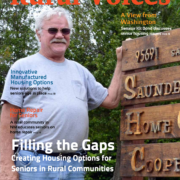HAC News: December 4, 2013
HAC News Formats. pdf
December 4, 2013
Vol. 42, No. 23
• Budget conference committee may develop two-year plan • USDA expects to have RA funds soon • RA shortfall later in FY14 will be bigger than last year’s • Continuum of Care funds offered • HUD opens new student design and planning competition • Difficult Development Areas announced for 2014 • VA proposes regulations for Home Improvements and Structural Alterations program • HUD finds continued decline in homelessness • Regulators adopt revised CRA questions and answers • Online mapping tool shows race and ethnicity in U.S. places • Rural seniors’ housing covered in Rural Voices magazine
December 4, 2013
Vol. 42, No. 23
BUDGET CONFERENCE COMMITTEE MAY DEVELOP TWO-YEAR PLAN. While the federal government operates under a continuing resolution through January 15, a House-Senate budget conference committee is to report out an overall budget template by December 13. Then the appropriations committees will produce agency bills, an omnibus spending bill, or a CR for the remainder of FY14. Also looming is another round of sequester cuts. Congressional Quarterly and Politico report that the conference committee is focusing on a limited plan to finish 2014 and cover all of 2015. It would include some relief from the sequester, a two-year discretionary spending template for appropriators, and possible fee-based revenue increases.
USDA EXPECTS TO HAVE RA FUNDS SOON. Some confusion occurred in November when USDA RD informed field staff that it had used up its Rental Assistance funding under the CR. In FY13, USDA used 22% of the $837 million annual RA appropriation between October 1 and January 15, so OMB released the same amount this year. In FY14, however, because FY13 September contracts were renewed after October 1 and some long-term contracts also needed to be renewed, USDA expects to need 52% of $837 million by January 15. OMB has the authority to release the full 52% during the term of the CR and is expected to approve USDA’s request to do so. When the funding becomes available, contracts that expired but were on hold awaiting funds will be renewed and paid retroactively.
RA SHORTFALL LATER IN FY14 WILL BE BIGGER THAN LAST YEAR’S. USDA faces increased demand for Section 521 Rental Assistance funds this year for three reasons, possibly four. First, contracts for about 15,000 units were held over from September and renewed using FY14 funds. Second, about 26,000 long-term RA contracts will expire this year and must be renewed for one-year terms. Contracts covering a total of 39,382 units, created over two decades ago for terms of 20 years or longer, had enough funding to last far beyond their original terms. HAC calculates that $105 million will be needed to renew the additional 26,000 units in 2014 and eventually a total of $160.4 million will be needed for all 39,382. Third, if RA funding for the rest of the fiscal year continues at the same level as FY13, it will again fall short by another approximately 15,000 units. A final possible threat will come if sequestration is not changed for 2014; USDA would have to cut some of its spending, and there are not yet any indications where those cuts might take place. More background is provided in a new Rural Research Note from HAC, “As Overall Program Funding for USDA/Rural Development Shrinks, the Need for Rental Assistance is Growing.” Additional papers and updates will be posted at https://ruralhome.org as available.
CONTINUUM OF CARE FUNDS OFFERED. Applications must be submitted through e-snaps by February 3. Con-tact a HUD field office or submit a question through the OneCPD website.
HUD OPENS NEW STUDENT DESIGN AND PLANNING COMPETITION. Teams of graduate students will develop plans for a site owned by a PHA, including architectural designs, neighborhood planning, and financial plans. Teams may begin registering now. Contact Claire Desjardins, HUD, 202-402-5945.
DIFFICULT DEVELOPMENT AREAS ANNOUNCED FOR 2014. Lists of DDAs and Qualified Census Tracts (the April 20, 2012 QCT designations remain in effect) are posted at https://www.huduser.org/datasets/qct.html. Contact Michael K. Hollar, HUD, 202-402-5878.
VA PROPOSES REGULATIONS FOR HOME IMPROVEMENTS AND STRUCTURAL ALTERATIONS PROGRAM. HISA funds necessary home improvements and alterations for disabled veterans. Comments are due January 21. Contact Shayla Mitchell, VA, 202-461-0366.
HUD FINDS CONTINUED DECLINE IN HOMELESSNESS. Point-in-Time Estimates of Homelessness, Part 1 of HUD’s 2013 Annual Homeless Assessment Report (AHAR) to Congress, reports a reduction of 3.8% since 2012 and 6.1% since 2010. Data are aggregated by state and by Continuum of Care.
REGULATORS ADOPT REVISED CRA QUESTIONS AND ANSWERS. The federal agencies that regulate lenders subject to the Community Reinvestment Act made some changes in the interpretive questions and answers that were proposed in March (see HAC News, 3/21/13).
ONLINE MAPPING TOOL SHOWS RACE AND ETHNICITY IN U.S. PLACES. Using 2010 Census data, the Racial Dot Map, provided by the Weldon Cooper Center for Public Service at the University of Virginia, provides color-coded dots for each person in each census block, showing population density and integration/segregation.
RURAL SENIORS’ HOUSING COVERED IN RURAL VOICES MAGAZINE. The fall issue of HAC’s quarterly magazine is titled “Filling the Gaps: Creating Housing Options for Seniors in Rural Communities.” One print subscription per organization is free from Dan Stern, HAC 202-842-8600.


